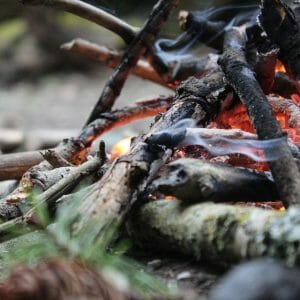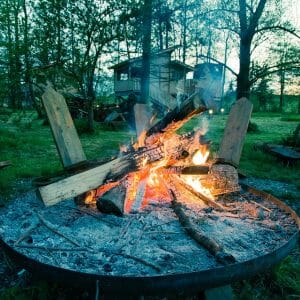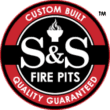 Wouldn’t it be great if the weather was warm and sunny every time you went camping? Weather such as this is ideal for camping. You don’t have to worry about your gear being washed away, nor do you have to worry about starting your campfire.
Wouldn’t it be great if the weather was warm and sunny every time you went camping? Weather such as this is ideal for camping. You don’t have to worry about your gear being washed away, nor do you have to worry about starting your campfire.
Unfortunately, there will be times when mother nature throws you a curve ball by bringing severe rain and storms during your camping trip. Whether you’re a seasoned camper or first-timer, you probably know that campfires are difficult to make in wet conditions. This doesn’t necessarily mean that you should pack up and head home, however. With the right approach, you can successfully build a roaring campfire in rainy weather.
Choose a Covered Location to Build Your Campfire
Perhaps the most important step in building a campfire in the rain is choosing the right location. If it’s raining, conventional wisdom should tell you that a covered campsite is necessary to your fire going. While it’s possible to build a campfire in a location that’s directly exposed to rain, you’ll have a much easier time if the area is covered.
Look for an area that offers some form of natural coverage and protection from the rain. Assuming you’re camping in the middle of woods, you probably won’t be able to find an area with complete, 100% coverage. You can, however, choose an area with a thick, dense tree canopy to shield your campfire from at least some of the rain. Tree canopies offer excellent protection from the rain, catching and distributing the water away from the base of the tree. Therefore, you’ll have an easier time building a campfire under a dense tree canopy if it’s raining.
Use a Fire Pit
In addition to building your campfire under a covered area, you should also consider using a fire pit. Using a portable fire pit, such as those offered here at S&S Fire Pit, you can further protect your campfire from the rain by keeping it off the ground.
Moisture from rain doesn’t come strictly from the skies; it also comes from the ground. When it rains, the ground will absorb and hold moisture, making it difficult to start a campfire. Instead of trying to build a campfire on the wet, water-logged soil, however, you can build it in a dry fire pit.
Strip Away the Outer Bark
You’ll need to collect the driest firewood possible to get your campfire going in the rain. Not surprisingly, downed limbs under dense canopies are usually the best source for such firewood.
After collecting a decent amount of firewood, use a sharp knife to remove the outer layer of bark. Even if the firewood looks dry, it’s probably holding some moisture due to the increased humidity levels accompanied with the rain. Being that the inner core of the wood is typically drier than the outside, however, you can strip away the outer layers so it lights more easily. Using a sharp knife, carefully scrape away the outer layers of your firewood, after which you should place the firewood directly in your fire pit until you’re ready to light it.
Use Lots of Kindling
 Want to know the secret to building a roaring-hot campfire in the rain? It’s using kindling, lots of kindling. Basically, wet wood requires hotter temperatures to ignite. And in order to create these hot temperatures, you need plenty of kindling. Tinder — the smaller stuff — is still important, but it’s the kindling that will ultimately create the hot flame needed for a campfire in the rain.
Want to know the secret to building a roaring-hot campfire in the rain? It’s using kindling, lots of kindling. Basically, wet wood requires hotter temperatures to ignite. And in order to create these hot temperatures, you need plenty of kindling. Tinder — the smaller stuff — is still important, but it’s the kindling that will ultimately create the hot flame needed for a campfire in the rain.
When gathering small sticks and twigs to use as kindling, make sure they are relatively dry. Like larger pieces of firewood, you can also strip away the outer layer so they light more easily. Once you’ve gathered the kindling, arrange it at the base of your campfire with the larger pieces of firewood on the outside. The key thing to remember is that the center of your campfire should be somewhat open so that air can flow through.
Beware of the Smoke
Wet firewood doesn’t burn as “completely” or efficiently as dry, seasoned firewood. This means campfires built in rainy weather or other wet conditions will produce more smoke — and that smoke could pose a risk to your health.
While some people prefer the distinct smell of campfire smoke, you should keep your distance and avoid inhaling it, especially if the wood is wet. Wet firewood produces more smoke when burned than dry firewood, making it more hazardous to your health. The good news is that you can easily avoid your campfire’s smoke by positioning yourself in the opposite direction of the wind. If the wind is blowing south, for instance, position yourself north of your campfire.
Building a campfire in the rain isn’t always easy. You’ll need to choose a covered location, find dry or semi-dry firewood, use plenty of kindling and more. However, once you get it going you’ll be able to enjoy the warmth and relaxing ambiance it offers during this otherwise messy weather. Hopefully, this gives you a better idea of how to create a campfire in rainy weather.
If you have any questions regarding how an S&S Fire Pit can enhance your outdoor living space; We can help. https://ssfirepits.com/contact/


